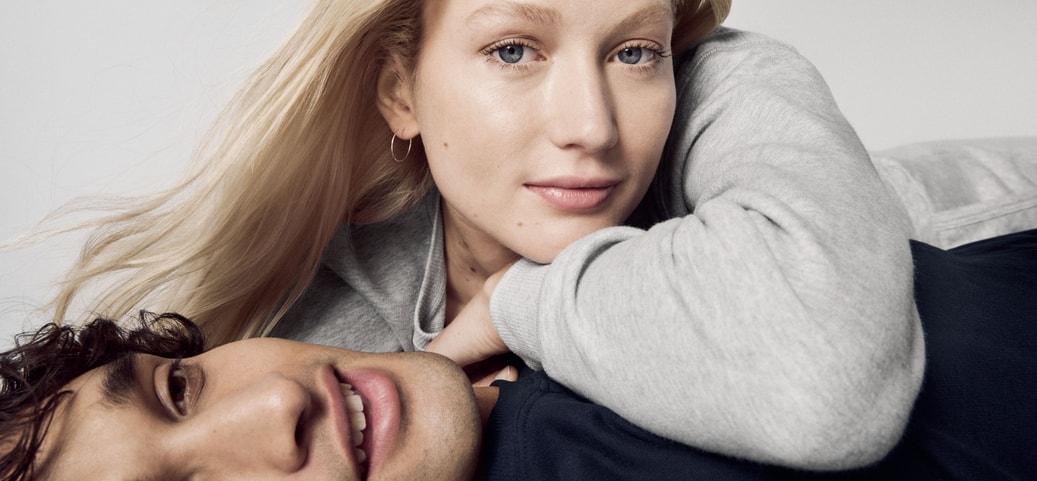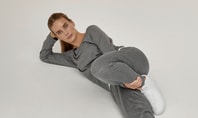Combine an onion look: From practical outfit to fashion statement
You probably know the situation: it's freezing cold in the morning, the temperature rises at lunchtime and then it gets chilly again in the evening - in between going to the office, shopping and you also want to be prepared for a walk in the afternoon. The onion look was invented precisely for these changeable conditions! The idea is to wear several layers of clothing on top of each other in order to adapt flexibly to the temperature and weather conditions. The onion look is particularly popular in winter - because when it gets really cold outside, the different layers help you to stay warm and stylish through the cold season.
by CALIDA
January 22, 2025•3 min reading time

Onion look: The perfect style for every season. Fashionable and functional layering through spring, autumn and winter!
Table of Contents
Layering and its benefits: what even is layering?
Perfect layering: stunning styling layer by layer
• The base layer: underwear that controls moisture with the perfect fit
• The warm layer(s): take account of the circumstances and the temperatures
• The protective layer: perfectly prepared for wind and weather
Three styling tips for layering: combining colours and materials
• Tip 1: stick to the same colour family
Layering and its benefits: what even is layering?
The concept of layering is simple: different layers of clothing are worn on top of one another – starting with the base layer right against your skin, then one or more warm layers, and finally the outer layer that protects against wind and weather.
The idea behind it is that you can take individual layers on or off as required to prevent yourself from feeling chilly or getting sweaty – no matter how cold it is outside. That means you feel great from head to toe, whether you’re on a pleasant stroll in mild autumn weather or trudging through the snow in the deepest winter.
Another benefit: with clever combinations, layered outfits for women can be not just functional but visually appealing, too. With a few simple fashion tricks, a layered look can quickly become a true fashion statement.
Perfect layering: stunning styling layer by layer
Layering refers to the clever combination of different garments, materials and cuts. The aim is to create a harmonious layered look that is not only practical but also appealing to the eye. The right order is crucial:
Base layer (bottom layer)
Insulation layer (middle or warm layers)
Outer layer (outermost layer)
Depending on the weather and time of year, you can vary the number of layers and their insulating and warming effect. In mild autumn weather, two warmer or three thinner layers are often enough, while in winter, you can wear thermal underwear under your wool or fleece pullover to stay cosy and warm.
We’d like to give you a closer look at the different layers, their functions and some example garments.
The base layer: underwear that controls moisture with the perfect fit
The base layer – usually underwear – lays the groundwork for all the layers on top. With this layer, the clothing should be close to the body so it can trap as much body heat as possible. Thermal underwear or lightweight long-sleeved shirts made from Merino wool and functional materials that wick moisture away from the skin are ideal.
This is particularly important, as sweat combined with cool air might cause unpleasant chills. Cotton tends to absorb moisture, so it is not suitable in this case. The same goes for your socks, by the way: if your feet get cold quickly, it’s worth wearing a pair made of warming wool or other insulating materials.
The warm layer(s): take account of the circumstances and the temperatures
The thermal layer, also known as the insulation layer, goes on top of the base layer. This is where jumpers, cardigans and padded vests come into play to protect you from the cold.
The number of warm layers you put on depends on the temperature and how much you personally feel the cold. While a light wool jumper is often enough in autumn, several layers may be required in winter: a fleece jacket under a thick knitted jumper, plus a lightweight, padded vest, and you’re perfectly set for sub-zero temperatures.
When choosing the warm layer, make sure it’s breathable, so that excess moisture that has been drawn away from the base layer can escape easily. High-quality materials such as Merino wool, fleece or down are ideal here; they keep you warm without making you sweat.
The protective layer: perfectly prepared for wind and weather
On top of this comes the outer layer – your last defence against wind, rain and snow. A windproof, water-repellent jacket or coat will keep the heat inside and the changeable weather outside.
Hardshell jackets or waterproof parkas are ideal for rainy days – they’re robust and not only withstand wet weather, but also the occasional stiff breeze. If you want to protect yourself against the cold and wind, in particular, you can also opt for a high-quality wool coat. Thanks to its layer of natural oils, it also protects against brief autumn showers.
When it comes to accessories, you can complete your look with a hat, scarf and gloves. These items of clothing are also part of the layering principle and contribute to making you feel comfortable. You’ll be prepared for any change in the weather without compromising on style.

Three styling tips for layering: combining colours and materials
For women, layering isn’t just about practicality – you can also use the concept to achieve creative, fashionable outfits. Here are three tips on how to play with colours, materials and cuts to make your layered look eye-catching:
Tip 1: stick to the same colour family
Choose your clothing layers in a similar colour palette to create a harmonious overall impression. Different shades of one colour can be very elegant and pleasant to look at. For example, you can combine a sand-coloured jumper with a beige vest and a light brown jacket. This looks classy without all the layers making it look excessive.
Tip 2: different materials add variety and warmth
Want to add more depth and structure to your outfit? Then try combining materials with one another. A thin long-sleeve shirt under a chunky knitted pullover, a light fleece vest and a windproof outer layer on top – different materials create an exciting mix of styles. This not only keeps you warm, but also looks fashionable and sophisticated.
Accessories in diverse materials can also add interesting touches – how about a silk scarf combined with a cosy woollen hat, for example?
Tip 3: combine tight-fitting and loose-fitting garments
Playing around with the silhouette is particularly appealing when layering, albeit quite challenging, as the different layers may hide your shape. For this reason, always opt for close-fitting basics such as functional underwear or a figure-hugging shirt as a base layer to keep all your options open.
For example, you could select looser-cut, chunky knitted jumpers or looser-cut, lined jackets and show off your legs instead – for example, with tight-fitting thermal tights. You could also opt for a waisted trench coat or leave your jacket unbuttoned – depending on the temperature – and wear clothing underneath this that accentuates your figure a little more. Use these tricks to create flattering and exciting layered outfits that are perfect for any temperature, without being too bulky.
Discover more interesting blog posts:


